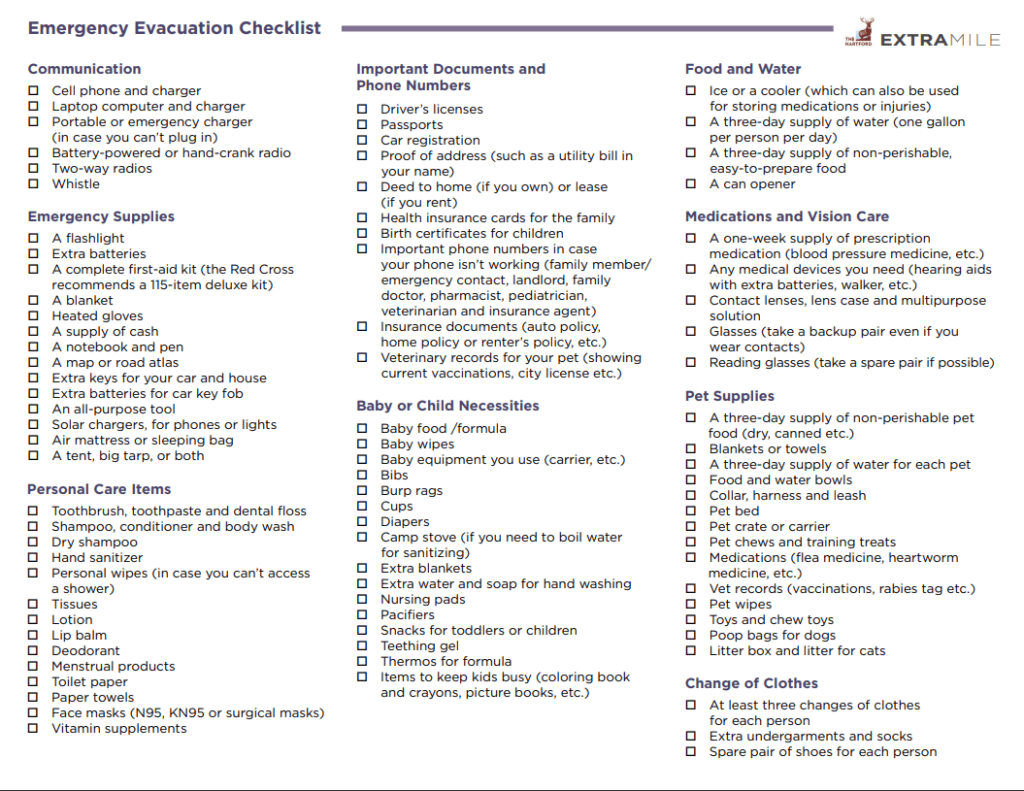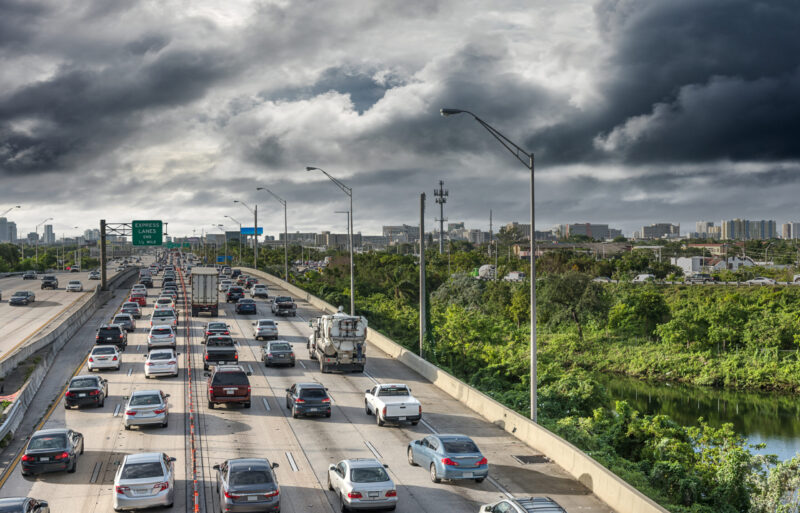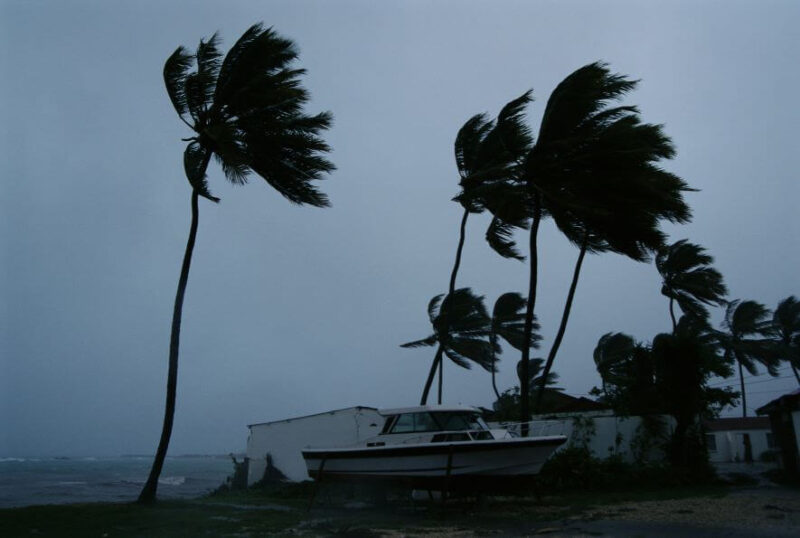Weathering a storm, fire or other disaster starts with making an emergency evacuation plan for you and your family — including a detailed list of what to take with you.
The items you take may include clothing, food, water, medication, insurance documents and possibly even a few sentimental items like a journal or old photos. What you take will vary based on your household and needs. For example, you might have a baby or a pet that requires special accommodations or a family member who takes daily medication.
Start by making sure each family member has a backpack or other bag that’s sturdy, water-resistant and easy to carry, with pockets or compartments for finding items quickly. You may also want to get a container you can easily grab and place in your car for documents and other paper items.
Here are the things you may want to include when making your list of what to take with you if you evacuate your home.
Communication
Communication is essential when you evacuate in a hurricane, a tornado or other disaster. You may need to call for help, reach family members if you get separated and let faraway loved ones know how you’re doing. Here are the communication essentials to take when you evacuate:
- Cell phone and charger
- Laptop computer and charger
- Portable or emergency charger (in case you can’t plug in)
- Battery-powered or hand-crank radio
- Two-way radios
- Whistle
Emergency Supplies
You’ll also need emergency supplies should you face unexpected or unusual situations such as cold or lack of electricity. Keep in mind that some of the things you usually rely on, such as ATMs, credit card machines and even your smartphone, may not be working. Pack these emergency items:
- A flashlight
- Extra batteries
- A complete first-aid kit (the Red Cross recommends a 115-item deluxe kit)
- A blanket
- Heated gloves
- A supply of cash
- A notebook and pen
- A map or road atlas
- Extra keys for your car and house
- Extra batteries for car key fob
- An all-purpose tool
- Solar chargers, for phones or lights
- Air mattress or sleeping bag
- A tent, big tarp, or both
Important Documents and Phone Numbers
It’s wise to have your important documents stored digitally so you can access them if physical copies get damaged. Here are some important documents to take:
- Driver’s licenses
- Passports
- Car registration
- Proof of address (such as a utility bill in your name)
- Deed to home (if you own) or lease (if you rent)
- Health insurance cards for the family
- Birth certificates for children
- Important phone numbers in case your phone isn’t working (family member/emergency contact, landlord, family doctor, pharmacist, pediatrician, veterinarian and insurance agent)
- Insurance documents (auto policy, home policy or renter’s policy, etc.)
- Veterinary records for your pet (showing current vaccinations, city license etc.)
Food and Water
Pack so that you and your family have enough food and water to get through at least three days. If you’re wondering what kind of food to put in an evacuation kit, experts recommend crackers, nut butter, dried fruit and nuts and seeds, juice boxes, energy bars, canned beans, canned fruit, canned meat and canned vegetables. Here’s what to pack to sustain you and your family:
- Ice or a cooler (which can also be used for storing medications or injuries)
- A three-day supply of water (one gallon per person per day)
- A three-day supply of non-perishable, easy-to-prepare food
- A can opener
Change of Clothes
Keep in mind that you may need multiple days’ worth of clothing, including a change of clothes in case what you’re wearing gets dirty or wet. Make sure to take:
- At least three changes of clothes for each person
- Extra undergarments and socks
- Spare pair of shoes for each person
Personal Care Items
The personal hygiene items you need to pack will vary based on your and your family’s needs, but here are some items you may want to include:
- Toothbrush, toothpaste and dental floss
- Shampoo, conditioner and body wash
- Dry shampoo
- Hand sanitizer
- Personal wipes (in case you can’t access a shower)
- Tissues
- Lotion
- Lip balm
- Deodorant
- Menstrual products
- Toilet paper
- Paper towels
- Face masks (N95, KN95 or surgical masks)
- Vitamin supplements
Medications and Vision Care
If you or someone in your family takes medication or wears contacts or glasses, make sure to consider that when you pack. Your evacuation kit should include these vision and medical supplies:
- A one-week supply of prescription medication (blood pressure medicine, etc.)
- Any medical devices you need (hearing aids with extra batteries, walker, etc.)
- Contact lenses, lens case and multipurpose solution
- Glasses (take a backup pair even if you wear contacts)
- Reading glasses (take a spare pair if possible)
If you or your family have special health or medical needs, make a list of items you’ll need to add to your evacuation kit. For example, here’s a list of evacuation items for people with diabetes and here’s a list of evacuation items for those with food allergies.
Baby or Child Necessities
If you have a baby or toddler in the family, you’ll need to pack special supplies. Here are the items you may want to take for babies and young children:
- Baby food /formula
- Baby wipes
- Baby equipment you use (carrier, etc.)
- Bibs
- Burp rags
- Cups
- Diapers
- Camp stove (if you need to boil water for sanitizing)
- Extra blankets
- Extra water and soap for hand washing
- Nursing pads
- Pacifiers
- Snacks for toddlers or children
- Teething gel
- Thermos for formula
- Items to keep kids busy (coloring book and crayons, picture books, y etc.)
Pet Supplies
If you have furry, feather or scaly family members, you’ll need to make an evacuation plan for them ahead of time since many shelters don’t accept pets. If you plan to evacuate with your pets to a relative’s home or hotel, you may want to take:
- A three-day supply of non-perishable pet food (dry, canned etc.)
- Blankets or towels
- A three-day supply of water for each pet
- Food and water bowls
- Collar, harness and leash
- Pet bed
- Pet crate or carrier
- Pet chews and training treats
- Medications (flea medicine, heartworm medicine, etc.)
- Vet records (vaccinations, rabies tag etc.)
- Pet wipes
- Toys and chew toys
- Poop bags for dogs
- Litter box and litter for cats
Sentimental Items
You never want to risk your safety by taking time to gather possessions when you’re trying to evacuate in a hurry. But if you plan ahead, you may be able to pack a few sentimental items such as your child’s first drawing or your grandma’s engagement ring. Consider picking the three items that have the most sentimental value to you (as long as they’re easily portable) and packing them ahead of time.
You may be able to pack many of these essential items in advance so they’re ready to gather quickly. You may then want to make a list of items you want to take but can’t pack in advance, like your phones and chargers, so you know what to grab before you go.
Download our Emergency Evacuation Checklist here.
Leaving in an emergency is stressful enough, which is why it’s important to be ready. Our emergency evacuation checklist can help.

Do you have an evacuation kit or list ready? Please comment and let us know. If you already have a kit, let us know if there was anything you forgot to include that you plan to add now.







It would have been better if the Emergency Evacuation Checklist was a white background with black type. I wanted to print it out, but the dark background would have used a lot of ink and made the paper soggy.
What great feedback, Jane! We just updated the checklist so you should be able to print it out and use much less ink. Thank you for contributing to the Extra Mile community!
Interesting list for evacuating. I have go bags set up, but have added a couple items from your list. I added lip balm and heated gloves. Thank you for helping me and all of us to be ready.
Helpful, wonderful and extremely useful article about the issue.
YOUR LISTS ARE GREAT AND VERY INCLUSIVE. UNFORTUNATELY, IF YOU PACK ANY AND ALL OF THE NECESSARY ITEMS SUGGESTED BY YOU, YOU WOULD VIRTUALLY NEED A TRUCK TO CARRY IT ALL, AND WHERE IN THE WORLD DO YOU STORE ALL OF THAT WITH THE ANTICIPATION THAT YOU MAY NEED IT SOMETIME IN THE FUTURE. ALSO, WHEN IT COMES TO SOME OF THOSE ITEMS YOU ARE DEALING WITH EXPIRATION DATES, ETC. AND WOULD HAVE TO HAVE A RUNNING LIST AND TIMELINE TO REPLACE THEM.
Very wise advice.
Register with first alert by zipcode to notify you of the approaching fire and alert you of evacuation routes that are blocked or open.